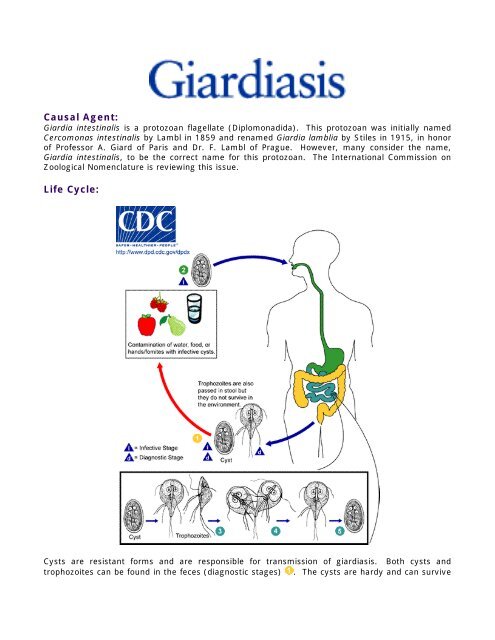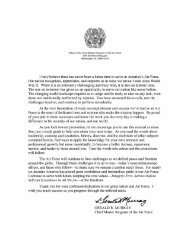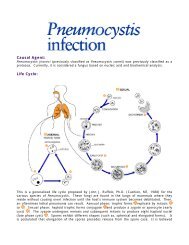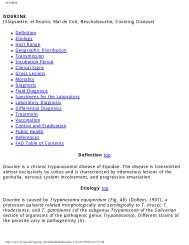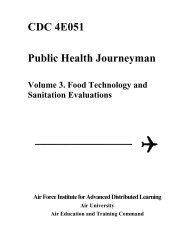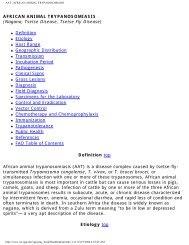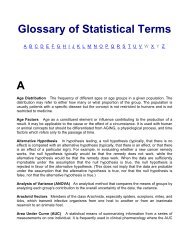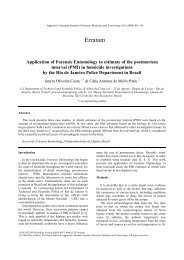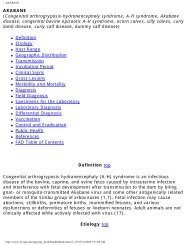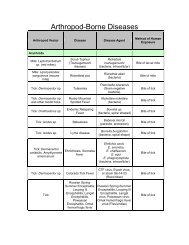Causal Agent: Life Cycle:
Causal Agent: Life Cycle:
Causal Agent: Life Cycle:
Create successful ePaper yourself
Turn your PDF publications into a flip-book with our unique Google optimized e-Paper software.
<strong>Causal</strong> <strong>Agent</strong>:<br />
Giardia intestinalis is a protozoan flagellate (Diplomonadida). This protozoan was initially named<br />
Cercomonas intestinalis by Lambl in 1859 and renamed Giardia lamblia by Stiles in 1915, in honor<br />
of Professor A. Giard of Paris and Dr. F. Lambl of Prague. However, many consider the name,<br />
Giardia intestinalis, to be the correct name for this protozoan. The International Commission on<br />
Zoological Nomenclature is reviewing this issue.<br />
<strong>Life</strong> <strong>Cycle</strong>:<br />
Cysts are resistant forms and are responsible for transmission of giardiasis. Both cysts and<br />
trophozoites can be found in the feces (diagnostic stages) . The cysts are hardy and can survive
several months in cold water. Infection occurs by the ingestion of cysts in contaminated water,<br />
food, or by the fecal-oral route (hands or fomites) . In the small intestine, excystation releases<br />
trophozoites (each cyst produces two trophozoites) . Trophozoites multiply by longitudinal<br />
binary fission, remaining in the lumen of the proximal small bowel where they can be free or<br />
attached to the mucosa by a ventral sucking disk . Encystation occurs as the parasites transit<br />
toward the colon. The cyst is the stage found most commonly in nondiarrheal feces . Because<br />
the cysts are infectious when passed in the stool or shortly afterward, person-to-person<br />
transmission is possible. While animals are infected with Giardia, their importance as a reservoir is<br />
unclear.<br />
Geographic Distribution:<br />
Worldwide, more prevalent in warm climates, and in children.<br />
Clinical Features:<br />
The spectrum varies from asymptomatic carriage to severe diarrhea and malabsorption. Acute<br />
giardiasis develops after an incubation period of 1 to 14 days (average of 7 days) and usually lasts<br />
1 to 3 weeks. Symptoms include diarrhea, abdominal pain, bloating, nausea, and vomiting. In<br />
chronic giardiasis the symptoms are recurrent and malabsorption and debilitation may occur.<br />
Laboratory Diagnosis:<br />
Giardiasis is diagnosed by the identification of cysts or trophozoites in the feces, using direct<br />
mounts as well as concentration procedures. Repeated samplings may be necessary. In addition,<br />
samples of duodenal fluid (e.g., Enterotest) or duodenal biopsy may demonstrate trophozoites.<br />
Alternate methods for detection include antigen detection tests by enzyme immunoassays, and<br />
detection of parasites by immunofluorescence. Both methods are available in commercial kits.<br />
Diagnostic findings<br />
• Microscopy<br />
• Molecular methods<br />
• Bench aid for Giardia<br />
Treatment:<br />
Several prescription drugs are available to treat giardiasis including metronidazole and<br />
tinidazole. Nitazoxanide has provided some encouraging results in the management of giardiasis in<br />
children


